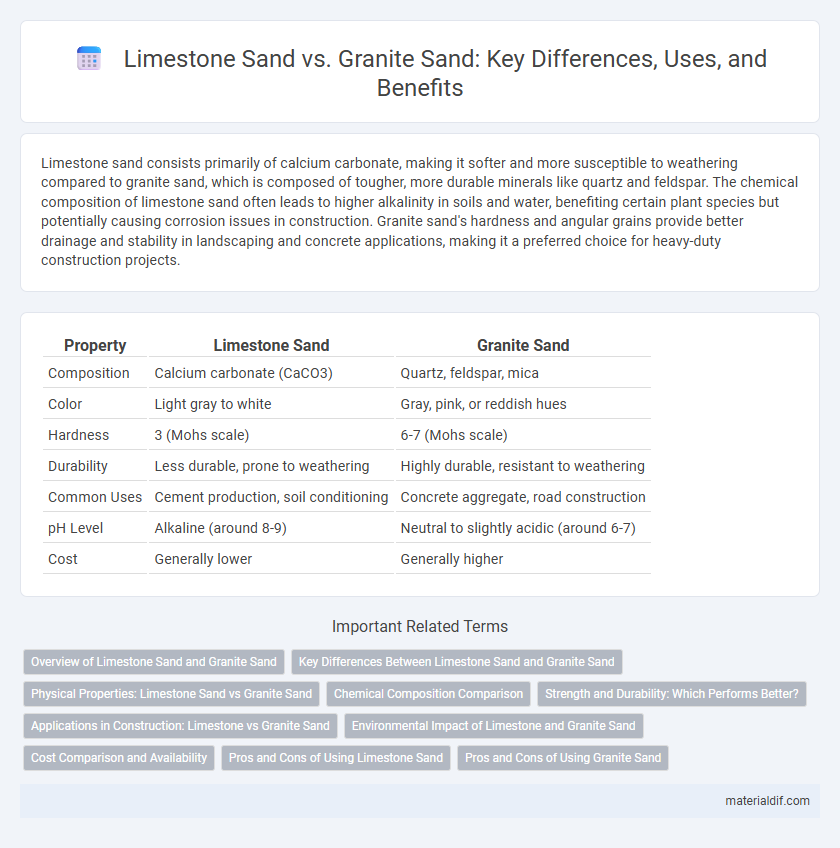Limestone sand consists primarily of calcium carbonate, making it softer and more susceptible to weathering compared to granite sand, which is composed of tougher, more durable minerals like quartz and feldspar. The chemical composition of limestone sand often leads to higher alkalinity in soils and water, benefiting certain plant species but potentially causing corrosion issues in construction. Granite sand's hardness and angular grains provide better drainage and stability in landscaping and concrete applications, making it a preferred choice for heavy-duty construction projects.
Table of Comparison
| Property | Limestone Sand | Granite Sand |
|---|---|---|
| Composition | Calcium carbonate (CaCO3) | Quartz, feldspar, mica |
| Color | Light gray to white | Gray, pink, or reddish hues |
| Hardness | 3 (Mohs scale) | 6-7 (Mohs scale) |
| Durability | Less durable, prone to weathering | Highly durable, resistant to weathering |
| Common Uses | Cement production, soil conditioning | Concrete aggregate, road construction |
| pH Level | Alkaline (around 8-9) | Neutral to slightly acidic (around 6-7) |
| Cost | Generally lower | Generally higher |
Overview of Limestone Sand and Granite Sand
Limestone sand primarily consists of calcium carbonate, offering excellent durability and a lighter color, making it ideal for construction and landscaping projects demanding aesthetic appeal and stability. Granite sand, composed mainly of quartz, feldspar, and mica, provides superior hardness and abrasion resistance, enhancing its performance in heavy-duty applications such as concrete production and industrial use. Both types of sand differ significantly in mineral composition and physical properties, influencing their suitability across various engineering and architectural purposes.
Key Differences Between Limestone Sand and Granite Sand
Limestone sand is composed primarily of calcium carbonate, resulting in higher alkalinity and smoother texture, while granite sand consists mainly of quartz and feldspar, providing greater hardness and angularity. Limestone sand is more reactive and dissolves faster in acidic environments, making it suitable for agricultural and construction applications needing pH buffering. Granite sand offers superior durability and mechanical strength, ideal for concrete aggregate and filtration media in heavy-duty engineering projects.
Physical Properties: Limestone Sand vs Granite Sand
Limestone sand exhibits lower hardness and higher porosity compared to granite sand, resulting in easier abrasion and increased water retention. Granite sand features greater density and resistance to weathering, providing enhanced durability and strength in construction applications. The mineral composition of limestone, primarily calcite, contrasts with the quartz and feldspar content of granite sand, influencing their respective physical behaviors.
Chemical Composition Comparison
Limestone sand primarily consists of calcium carbonate (CaCO3), making it rich in calcite and contributing to its alkaline nature. Granite sand contains a mixture of minerals including quartz, feldspar, and mica, with a dominant chemical composition of silicon dioxide (SiO2) and varying amounts of aluminum, potassium, and sodium oxides. The distinct chemical profiles influence their reactivity, durability, and suitability for construction and industrial applications.
Strength and Durability: Which Performs Better?
Granite sand offers superior strength due to its high quartz and feldspar content, making it ideal for construction projects requiring durability. Limestone sand, composed mainly of calcium carbonate, is softer and more prone to abrasion, impacting long-term strength negatively. For applications demanding robust structural integrity, granite sand outperforms limestone sand in both strength and durability metrics.
Applications in Construction: Limestone vs Granite Sand
Limestone sand is prized in construction for its high calcium carbonate content, making it ideal for cement production, concrete aggregates, and road base materials due to its strong binding properties. Granite sand, composed mainly of quartz and feldspar, is valued for its durability and resistance to weathering, making it suitable for high-strength concrete, asphalt mixtures, and decorative aggregates. Both types of sand offer unique benefits, with limestone sand enhancing workability and granite sand contributing to structural longevity in construction projects.
Environmental Impact of Limestone and Granite Sand
Limestone sand extraction often leads to habitat disruption and increased carbon dioxide emissions due to the calcination process, impacting local biodiversity and contributing to climate change. Granite sand mining typically causes less chemical pollution but results in significant land degradation and water table alteration, affecting soil quality and aquatic ecosystems. Both materials require careful management to minimize long-term environmental damage, emphasizing sustainable extraction practices and rehabilitation efforts.
Cost Comparison and Availability
Limestone sand generally costs less than granite sand due to its abundant availability and easier extraction process, especially in regions rich in sedimentary rock formations. Granite sand tends to be more expensive because it is harder to quarry and crush, with limited deposits found primarily in mountainous areas. The price difference also reflects transportation costs, as limestone sources are often closer to urban centers, reducing overall expense.
Pros and Cons of Using Limestone Sand
Limestone sand offers advantages such as higher workability and enhanced water retention, making it ideal for concrete mixes requiring better bonding. Its softer texture reduces wear on equipment but tends to have lower durability and strength compared to granite sand, limiting its use in heavy-load applications. Despite being more susceptible to weathering and chemical erosion, limestone sand is often favored in construction projects prioritizing ease of handling and cost-effectiveness.
Pros and Cons of Using Granite Sand
Granite sand offers superior durability and high resistance to weathering compared to limestone sand, making it ideal for construction projects requiring long-lasting materials. Its angular particles enhance bonding strength in concrete but may increase water demand and reduce workability during mixing. However, granite sand's mineral composition can introduce variability in color and texture, potentially affecting aesthetic preferences in architectural applications.
Limestone sand vs Granite sand Infographic

 materialdif.com
materialdif.com